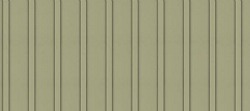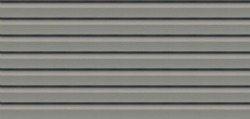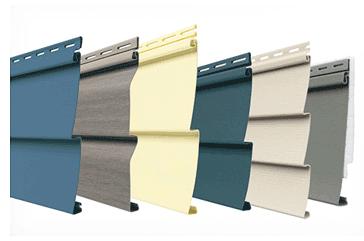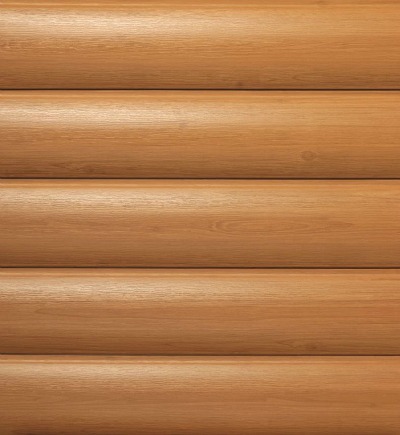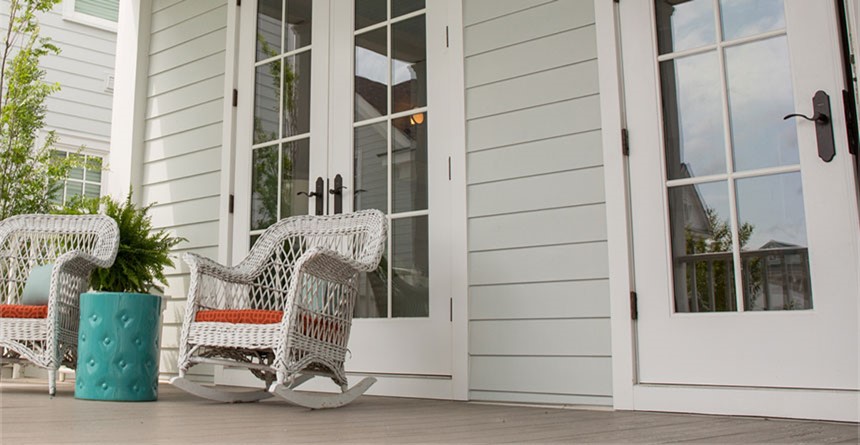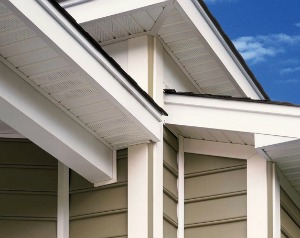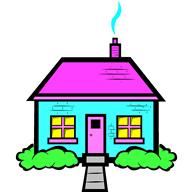Vinyl Siding is # 1
 Norandex Vinyl Siding
Norandex Vinyl SidingVinyl Siding is the #1 selling home siding material in the U.S.
Vinyl outsells all other siding materials put together!
Why?
- Easy to Install -
- Can be installed on almost any house -
- Makes your old house look brand NEW!
- Maintenance free, just hose it down a few times a year-looks brand new.
- Half the cost of real wood -
- Comes in many COLORS -
- Insect Proof - No Termite Damage
- Can Withstand Hurricane Winds -
- Very Affordable -
- Never Needs Painting!!
Vinyl Siding is the top selling home siding material in the US. Why? Because it comes in so many assorted colors, styles, thicknesses, types, insulated or non-insulated, and is available in most every part of the country, and is the most economical home siding you can buy!
Installing Vinyl house siding will make your older home look brand new.
Comes in many different Styles
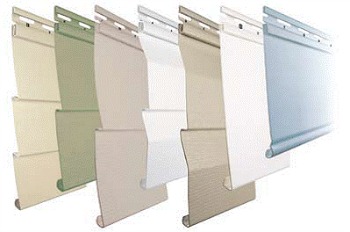 Clapboard Vinyl Siding Styles
Clapboard Vinyl Siding Styles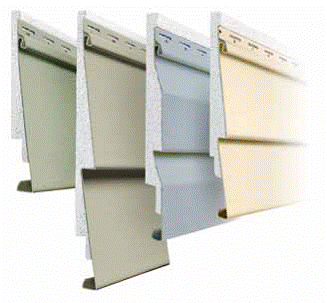 Insulated Vinyl Siding Styles
Insulated Vinyl Siding StylesVinyl house siding comes in many varied sizes, shapes, colors, thickness, lengths, insulated or non-insulated, styles and types. It is the number one selling house siding material sold in the U.S. It is affordable, can be installed over any house, is very reasonable in price, had extraordinarily little maintenance, and will make you old house look like brand new without breaking the bank.
Three main Types of Vinyl Siding
The three main types of vinyl siding are:
1. Board and Batten Vinyl Siding, sometimes called Vertical Vinyl Siding,
2. Clapboard Vinyl Siding, sometimes called Ship Lap Siding or Horizontal Siding,
3. Vinyl Cedar Shake Siding
Each type of siding comes in an array of colors, styles, thicknesses, textures, and prices.
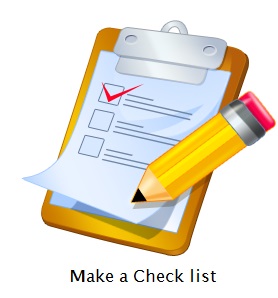
Interested in other types of home siding such as Hardie Board or Cement Board Siding,
Back to Vinyl Siding
Board and Batten Vinyl Siding
Board and batten vinyl siding, sometimes called Vertical vinyl siding is siding that runs up and down (vertically) on your house from top to bottom.
It has been a favorite home siding for hundreds of years and is still going strong.
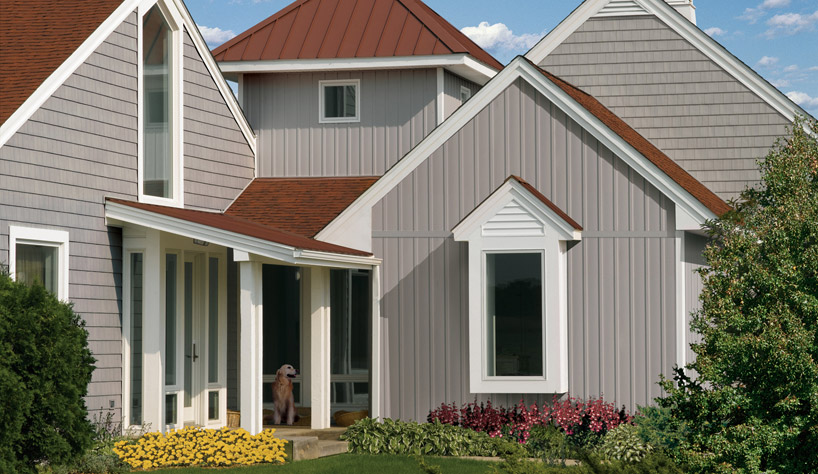 Board and Batten or Vertical vinyl sidng
Board and Batten or Vertical vinyl sidngBoard and Batten Siding or Vertical Siding runs up and down, or vertically up and down on your house.
Sometimes called "Barn Siding" because it was used on barns across the U.S. for hundreds of years.
It is still used today and comes in various widths and commonly used as an accent on garages and gables.
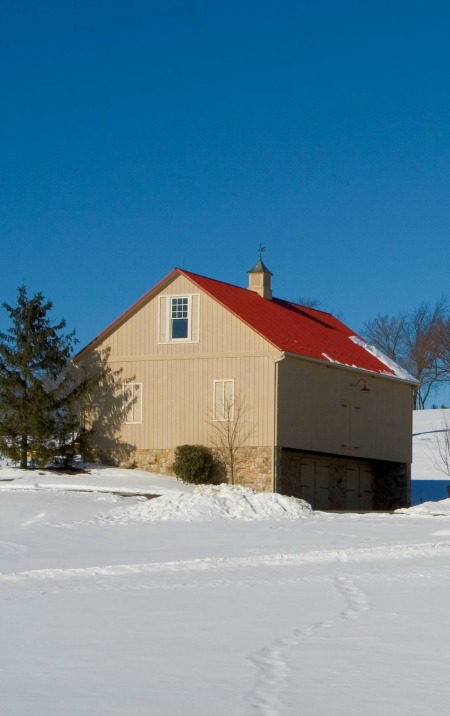 Board and Batten Siding sometimes called Barn Style Siding
Board and Batten Siding sometimes called Barn Style SidingClick here to see more info on Board and Batten Vinyl Siding
Clapboard Siding
Clapboard Siding is the most popular home siding in America. It outsells all other styles of home siding.
Clapboard Siding, or Horizontal Siding. It is sometimes called Colonial Style or Ship Lap Siding.
Looks like long wooden planks nailed horizontally across your house.
The different 'looks' of the siding is called the 'Profile' of the siding.
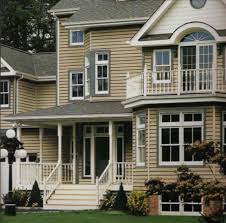 Clapboard or Horizontal Siding
Clapboard or Horizontal Siding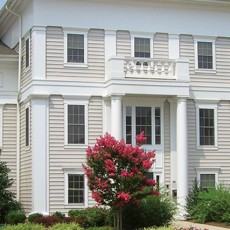 Clapboard Vinyl Siding. A classic look.
Clapboard Vinyl Siding. A classic look.The different shapes of the panels are called "Profiles" and are pretty standard throughout the industry. Although each manufacturer may alter size slightly. Always look at a sample of each to get the true size and look of the siding panels.
 Clapboard Siding Profiles
Clapboard Siding ProfilesTo see more information on Vinyl Siding Profiles, Click Here
Click here to see more info on Clapboard Siding
Cedar Shake Siding
 Vinyl Cedar Shake Siding
Vinyl Cedar Shake SidingCedar Shake Siding is and has been one of the most popular home siding materials for well over a century. It is a genuine classic with a warm natural, rustic outdoor traditional look. Nothing really comes close to its natural beauty.
Cedar Shake vinyl siding comes in a range of styles that look just like the real wooden cedar siding of yesteryear, but without the prohibitive cost and high maintenance associated with real wood siding.
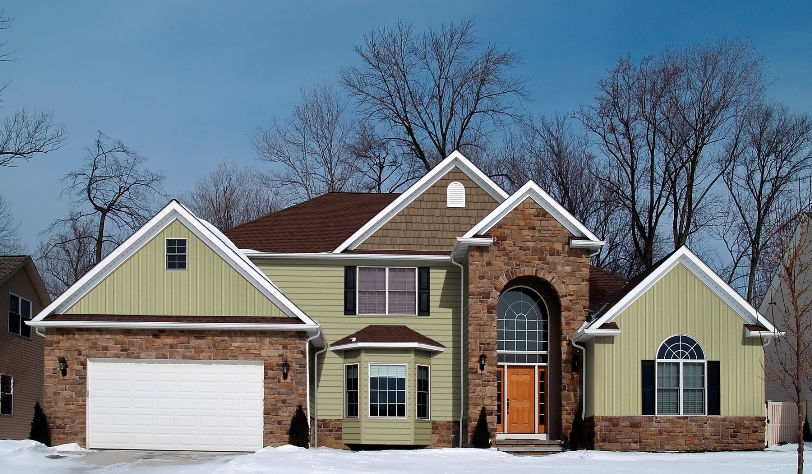 Vinyl Cedar Shake Siding
Vinyl Cedar Shake SidingTo see more information on Cedar Shake Siding, Click Here Cedar Shake Siding
Other Types of Siding
Other types of home siding include
Wood, Brick, Stone, Aluminum, Stucco, and Concrete Board Sidings, which include the Fiber Cement Board Sidings.
Although vinyl siding is the number one selling home siding in the U.S, there are a number of outstanding siding products available. Some are even more durable than vinyl, certainly more durable with less maintenance than real wood siding.
Hardie Board Siding
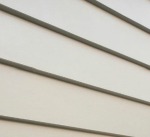 Hardie Board Siding
Hardie Board SidingHardie Board Siding is the world leader in fiber cement siding and backer board. They've been providing alternatives to natural wood siding for over a hundred years.
Why Use Hardie Board Siding?
James Hardie Board Siding products grace the side of more than 8 million homes across the US. For one big reason,
Beauty, and durability.
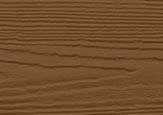 Hardie Board Siding
Hardie Board Siding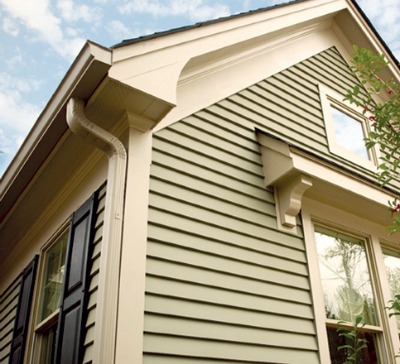 Hardie Board Siding
Hardie Board Siding91% of builders agree fiber cement siding increases a home's appraisal value. Re-siding your house with fiber cement siding provides the #1 return on investment of any major exterior remodeling projects, making it a better investment for your home. *
*Remodeling magazine 2020 cost vs value report, national data for exterior home replacement projects over $10,000.,
To see more information on the many James Hardie Board Siding products,
Click Here. Hardie Board Siding
Engineered Wood Siding
Engineered Wood Siding products have the look and texture of real wood siding only much stronger and more durable than real wood siding.
Engineered wood siding is less expensive than real wood siding, less maintenance than real wood, and looks exactly like wood. It resists insects, mold, and rot. It comes in all the popular styles such as Board and Batten, and Clapboard.
 Engineered Wood Siding Looks like wood without the high maintenance of real wood.
Engineered Wood Siding Looks like wood without the high maintenance of real wood. LP Smartside Engineered Wood Siding
LP Smartside Engineered Wood SidingTo see more information on Engineered Wood Siding, Click Here.
Guide to Siding Types 101
- Hardie Board Siding
- Cedar Shake Siding
- Vinyl Siding Cost
- Clapboard Siding
- Cleaning Vinyl Siding
- Types of Siding
- Cement Board Siding
- Board and Batten Siding
- Vinyl Siding Manufacturers
- Insulated Vinyl Siding
- Fiber Cement Board Siding
- How to Make a Siding Budget
Vinyl Log Siding
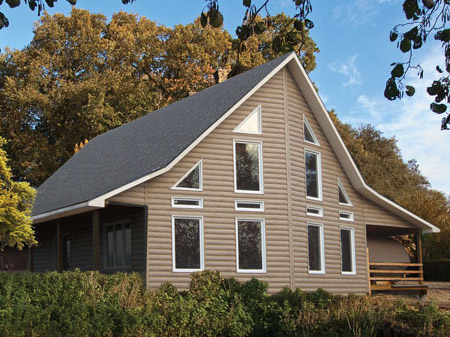 Vinyl Log Siding
Vinyl Log SidingVinyl Log Siding, rustic charm at its best. Today the vinyl log siding looks just like real cedar logs. It is much less expensive than real Cedar logs, requires much less maintenance than real wood, and it is resistant to rain, snow, harsh winter winds and never needs painting.
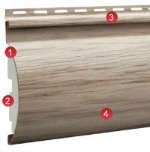 Vinyl Log Siding
Vinyl Log SidingIf you want the rustic look of cedar log cabin homes, the new vinyl log cabin siding is the way to go. Strong, durable, never needs painting or staining and is insect resistant.
To see more info on vinyl log siding click here.
Types of Siding
Other types of siding for homes include concrete board, engineered-wood siding, fiber cement board and Hardie Board Siding.
Hardie Board Siding
Hardie Board Siding is one of the most popular home sidings. Hardie Board or Cement Board siding is stronger than vinyl and has less maintenance than traditional wooden siding. Strong, minimal maintenance, insect resistant and wind and water resistant. Not to mention it looks great!
Hardie Board Siding comes in several styles. From rough cut cedar look to smooth lap siding.
 Hardie Plank Siding
Hardie Plank Siding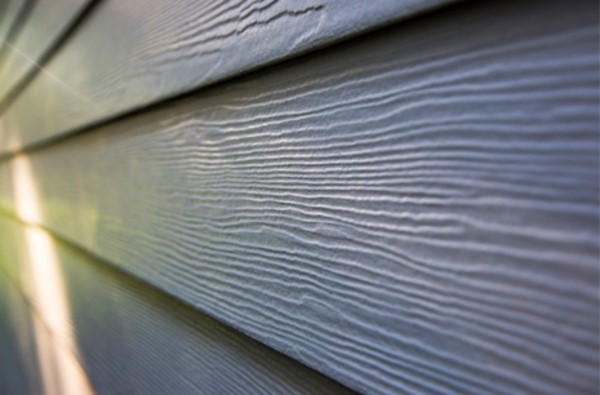 Hardie Board Siding looks like real wood only stonger
Hardie Board Siding looks like real wood only stonger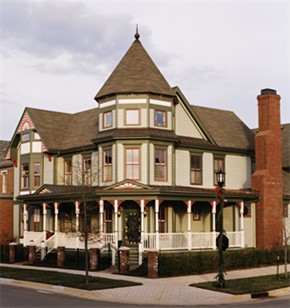 Hardie Board Siding can be used on many types of houses
Hardie Board Siding can be used on many types of houses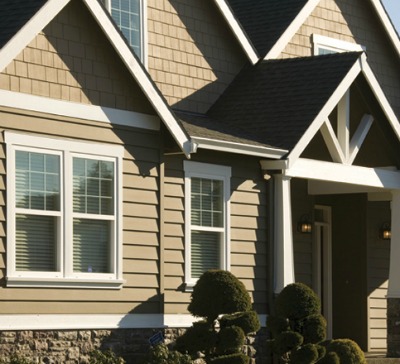 Hardie Board Siding comes in many styles
Hardie Board Siding comes in many stylesHardie Plank Siding is one of the more popular home siding materials sold. It is a man-made cement product that is stronger than wood, and more durable than vinyl siding. It is termite resistant, mold and rot-resistant and comes in many factory applied colors.
To see more about Hardie Plank Siding click here.
Cement Board Siding
Cement board siding looks like real wood siding but is much stronger. Sometimes it is called fiber cement board.
Comes in many of the popular types and styles.
 Cement Board Siding
Cement Board Siding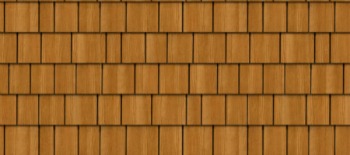 Allura Fiber Cement Board Siding
Allura Fiber Cement Board SidingConcrete fiber board or concrete board siding is made mostly of Portland cement, clay, and sand with wood fibers. It has become one of the most rugged siding available with great durability and minimal maintenance. It is highly weather resistant but needs periodic painting to keep looking new.
Pro's
Accepts repainting easily, very weather resistant, fire resistant, and insect resistant. it is considered to be a masonry product and, in some states, may qualify for lower insurance costs. Comes in a wide variety of styles, colors, and textures.
Con's
It is very heavy and requires specially application techniques. This adds to the cost, average 50 % greater than vinyl.
Generally, requires a complete tear off existing siding.
To see more information and pictures of Cement Board Siding Click Here
Engineered Wood Siding
To see more examples of Engineered Wood Siding Click Here
Fiber Cement Siding
Fiber cement siding is another cement-based home siding product. Very strong and durable, stronger than viny sidings. Can be painted any color. To see more information on Fiber Cement Sidings Click here
Vinyl Siding Cost

How much does vinyl siding cost? Vinyl prices range from about $3 per square foot installed to well over $10 per square foot installed. It all depends on the quality of siding you pick out and the shape and size of your house.
There are several things that go into the pricing of installing the siding. There is no general rule of thumb.
The shape of your house is particularly important also. How many corners is there? How many windows? How much work is there to be done to fix water and termite damage?
Vinyl Siding Cost is made up of several different components.
- The price of the actual siding
- The cost to make the house ready for the new siding
- The cost of any repair, or replacing any water or insect damage
- Trim and Add On's such as window and door trim, soffit and facia
- Size of the house, and the number of stories, and the number of corners
- Time of year
- Addition of insulation, either behind the new siding or using insulated siding
To see more information on vinyl siding prices and siding cost in general
.. click here...Vinyl Siding Prices.
There are other costs associated with putting new vinyl siding on your home. Read the material below before you call your contractor to give you a price.
The more you know about the application of siding on your home the easier it will be for you to talk intelligently about your project.
And take notes!


There are other costs associated with installing vinyl siding you your house. The actual siding is only one part of the 'installation process' and there are other costs associated with the installation that will affect the total cost of the project.
Vinyl Siding Cost and the items used to come up with the actual project cost.
For more information on Cost Click Here
Vinyl Siding Colors
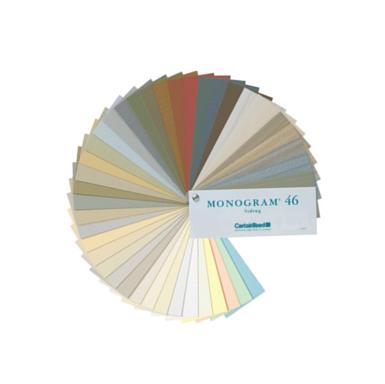 Vinyl Siding comes in many different colors
Vinyl Siding comes in many different colorsVinyl siding color combinations are endless. Each manufacturer has specific colors plus a wide array of standard colors. Always look at a sample of the siding to judge its true color. Your contractor can get you samples of any color, just ask him. Don't rely on pictures on the internet or brochure.
There are many different vinyl siding colors to choose from. Let your imagination be your guide. Each company has the basic colors, and most manufacturers have their own special colors.
One of the wonderful things about choosing a color for your new vinyl is that you never have to paint it again.
The colors are permeant and you never have to repaint! Maintenance is incredibly low, just wash it down with your water hose occasionally to bring back the beauty.
To see more info on the many different vinyl siding colors, click here.
How to Buy Vinyl Siding
How to buy vinyl siding is a process that takes several different steps to get through.
Buying vinyl siding is a process that requires a little homework. There are several different steps in the buying process. Selecting the right siding for your house, preparing your house for the installation of the siding, and picking and choosing the right contractor. We suggest you always us a licensed contractor for the installation.
If you are just starting to look for vinyl siding for your home, it can become daunting because of the many distinct types and styles.
It is best to research several distinct products in order to find the one that best fits your needs, budget, and home style.
Like all products vinyl products comes in all prices, shapes, and textures.
To see more information on How to Buy Vinyl Siding for your home Click Here Buy Vinyl Siding
 Mr. Contractor Says
Mr. Contractor Says Take Notes
Take NotesUse this site to compare and research many different siding products. Make notes on the products that you like, and think would look good on your home.
Use these notes to talk to your contractor to make sure you get the absolute best siding for your home.
Installing siding should always be done by a professional. Professionals can do it better than the homeowner because they do it all the time!
Always use a licensed contractor to install your vinyl siding!!
Print out this Siding Worksheet to make note on. Siding Worksheet Printout Click Here
History of Home siding
There is a long history of home siding. Ever since man left the cave and started to build houses, he has wanted to put material around it. Sometimes to protect it from the weather, frigid winter winds, or freezing rain, or animals.
Sometimes just to make it look nicer.
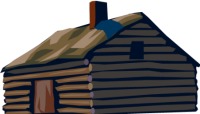
Homeowners have used wood to cover their homes since there were homes. Click here to see more on the history of siding on homes.
Vinyl siding is made to mimic real wood siding. So, any type and style of wooden home siding is now available in vinyl.
Vinyl Siding Styles
Vinyl Siding Styles come in many different shapes, sizes, thickness, smooth or rough cut like real cedar wood, shakes, shingles, and even insulated or non-insulated versions.
Within each group of siding there are many different 'styles'.
Types and styles of vinyl siding often get confusing, but your contractor will know what you are talking about.

Vinyl siding comes in many assorted colors, lengths, textures, profiles, thickness, and prices.
It is helpful to look over the many distinct products and make notes on the ones you think will look best on your house and one that fits your budget.
To see more info on the many different siding styles, click here...
What are you interested in?
- Board and Batten
- Dutch Lap
- Insulated
- Profiles
- Clapboard
- Lap Siding
- Ship Lap Siding
- Beaded Siding
- Cement Board Siding
- Fiber Cement Board Siding
- Vinyl Siding Cost
- Engineered Wood Siding
Vinyl Siding Trim and Accessories
Don't forget your trim! You should always add vinyl trim to your windows and doors to make your home maintenance go away.
Cover everything so you never have to paint again!
I want to see some pictures of siding on homes.
Good articles for homeowner's DIY Articles
- Paint
- Pressure washing your vinyl siding
- Make a budget
- Measure your house
- Figure sq ft
Vinyl Siding Manufacturers
To see more informaiton on the major vinyl siding manufacturers in your area go to the Vinyl Siding Manufacturers site or just click on one of the siding companies you are interested in.
Major Vinyl Siding Manufacturers:
How to Buy Siding...The Easy Way?
 Mr Contractor says
Mr Contractor says
This site is designed by some old home improvement contractors. Every day we work with homeowners who what to install siding on their houses but have no idea how to get started. We will show you how to get started and what to do first, second and so on.
Our goal is to guide you along and show you how to work with your contractor to ensure that you choose the best siding products for your house and get the very best price possible.
Homeowners need to have done some basic homework and have several basic facts about siding they have chosen to go on their house... before calling any contractors, otherwise you will not know the proper questions to ask the contractor. If you don't know exactly what to ask for, you won't get it!
We will show you how to gather important that will allow you to pick the best siding for your house and how to work with your contractor to get the very best price possible.
Click here for more information on How to Buy Siding

Comparing Different Products
Save time and money by doing a little homework before calling contractors for price quotes:
- Pick out the type of siding you think will look good on your house; vertical, horizontal or shakes (most people mix and match several distinct types to use on their homes).
- Choose the style; colors, profiles, texture, and thickness that you like.
- Compare prices, see what other people are paying for comparable products in your area.
- Then call several contractors and have them give you prices based on the products you have already picked out. Now you can easily compare different quotes apples 2 apples.
- This will save you a lot of time and money!
Click here for more information
Choosing a style of vinyl siding is one of the most important steps. And should be done first, everything else will depend on the style of siding you choose.
When people say Style, they are usually referring to one of the three main 'styles' of siding, horizontal, vertical or shakes. Of course, each of these styles comes in many different and diverse selections. Each has its own profiles, textures, thickness, and colors.
Each type of siding has different 'Profiles' that are characteristic to that type of siding. Clapboard, dutch lap, beaded, cedar shake, board and batten all come in different widths.
Profiles are how wide each board or panel is and whether it has a notch or shadow groove. There are wide boards and there are are very narrow boards. Generally, each panel will run approximately 3" to 10" in width.
In addition to the profile, there are different 'textures' of the boards or panels. Since vinyl siding is made to look like real wood, and real wood has a texture that ranges from exceptionally smooth like sanded boards, to a deep grain that looks like real cedar wood.
To see more about the different Siding Styles, click here.
Comparing Prices
Comparing prices can be done once you have chosen the type, style, amount needed, insulated or non-insulated, thickness, color and so forth. Follow this site and we will guide you through the process.
You need to shop around and compare some prices from the local home improvement stores like Home Depot and Lowe's. Otherwise you will have no idea if the price the contractor quotes you is a fair price or not.
What goes into the quote?
What goes into the quote when the contractor gives you a price to install the siding on your home?
How much does it really cost to install new siding on your house?
Total cost is made up of several different pricing components.
- How much siding (sq ft) you will need, and the quality of the siding you choose. Quality + Quantity.
- What the contractor charges to install the siding.
- How much labor will it take to make your house ready to have the siding installed.
Every house is different so the amount of siding needed will vary house to house and so will the amount of work the contractor has to do to make your house ready for the siding to be installed.
- Do you have old siding that needs to be removed?
- Do you have rotted wood that needs to be repaired or replaced?
- Do you have termite damage that needs to be repaired?
- Do you need new soffit or facia?
- Do you want new gutters?
There are many different items that goes into the final 'cost' of your new siding installation.
Other Types of Siding
Wood Siding
The most popular and time-tested form of siding for a home. Wood is one of the most expensive types of siding for your home. Long considered one of the most beautiful sidings available for homes.
Comes in a wide variety of types such as shake, clapboard, singles, and lap. It can be applied both vertically or horizontally.
Pro's: Warm and beautiful. Lasts longer than most other types of sidings. Adds charm to homes that only real wood can offer. Has superior aesthetics. Has natural insulating qualities.
Con's: Expensive, requires regular maintenance such as painting and/or staining (as often as every 3 to 5 years depending on location). Can not be applied over other existing sidings, so a total tear off of existing siding must be done first. Non-moisture resistant species like pine and fir are highly susceptible to rot, and insects. Is not fire resistant.
Concrete fiber board or concrete board also sometimes called Hardie Board or Hardy Board is made mostly of Portland cement, clay, and sand with wood fibers. It has become one of the most rugged sidings available with great durability and low maintenance. It is highly weather resistant but needs periodic painting to keep looking new.
Pro's: Accepts repainting easily, very weather resistant, fire resistant, and insect resistant. It is considered to be a masonry product and, in some states, may qualify for lower insurance costs. Comes in a wide variety of styles, colors and textures.
Con's: Is very heavy and requires specially applicators and application techniques. This adds substantially to the cost (average 50% greater than vinyl). Generally, requires a complete tear off existing siding (add 5% to 10% to job)
Aluminum Siding
Aluminum siding comes in a wide range of factory finished colors and styles from smooth to wood grain. Slightly more expensive to install but should last 25+ years with little maintenance.
Pro's: Factory baked on finishes last many years with little or no maintenance. Aluminum siding is insect and fire resistance. Can be touched up with special paint as needed. Easy to clean with soap and water.
Con's: It is prone to denting, sometimes even by hailstorms. Easy to scratch, bicycles and balls cause permanent dents and dings. Has no insulating qualities by itself?
